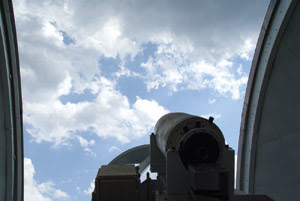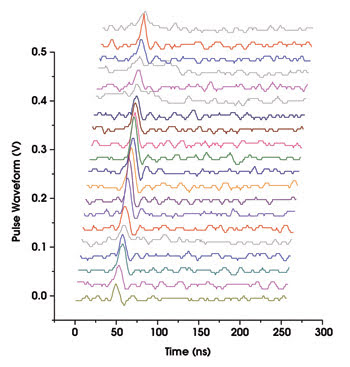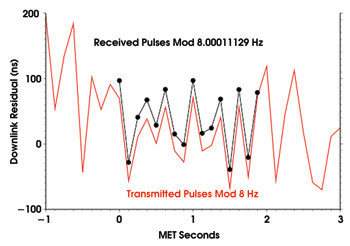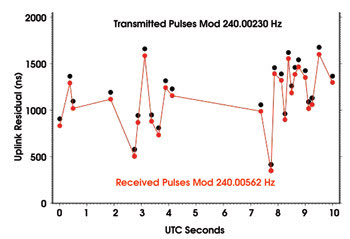A scientist in a space project offers a personal account of the story behind a groundbreaking laser-ranging experiment across 24 million kilometers.
Maria T. Zuber, MIT and NASA’s Goddard Space Flight Center
In late May 2005, my colleagues and I performed the first two-way laser link over an interplanetary distance.1 In doing so, we set the record for the longest distance over which a laser pulse has been detected.
Not long after the experiment, I attended a meeting with MIT’s president, Susan Hockfield. She congratulated me, saying that she had understood that we had succeeded at doing something that was both important and very difficult. That said, she asked if I could explain why it had taken so long to get the experiment to work. At that time, we had been at it, on and off, for 13 years.
The history behind the experiment is illustrative of how technology often moves ahead by persistence, hard work and, in our case, occasional breaks in the clouds.
The story begins in the mid-1980s, when NASA’s Goddard Space Flight Center in Greenbelt, Md., had coalesced a group of individuals with disparate backgrounds but a common vision: to use lasers for science in space.
Lasers in space
David E. Smith, a terrestrial geodesist who had pioneered the measurement of the motion of the Earth’s tectonic plates using laser ranging to Lageos (LAser GEOdynamics Satellite), was turning his attention to the planets. He would tell anyone who would listen that we should be firing lasers throughout the inner solar system to measure planetary topography, study the orbits of the planets and measure subtle physical forces.
Simultaneously, John J. Degnan was developing concepts for asynchronous laser transponders in which two laser terminals would independently fire pulses at each other, with the timing recorded for analysis at a common location.2 He envisioned that these devices would enable precise interplanetary laser ranging and time transfer.
James B. Abshire was assembling a top-notch team to design and build the first long-lifetime laser altimetry systems for terrestrial and planetary science remote-sensing applications.
I was a postdoctoral researcher, coming off a thesis in geophysical fluid dynamics.
The practical application of lasers to the investigation of the solar system would require tangible demonstrations of laser technology in space; that is, establishing long lifetimes, accurate pulse timing, and precise pointing and platform stability. Although we on the instrument side would drive the design of the laser transmitter and receiver technology, the pointing and stability, while technically manageable, largely would be out of our direct control.
Hitching a ride to Mars
The robotic spacecraft that map the planets, on which our sensors would “hitch a ride,” typically are designed to point and scan well enough to target images at the milliradian level. This isn’t good enough for precise ranging with 0.1-mrad or narrower laser beams. To demonstrate the requisite transponder technology, we needed to range from a spacecraft to Earth and vice versa.
The initial attempt came with our instrument, the Mars Observer Laser Altimeter (MOLA), which launched on the Mars Observer spacecraft in August 1992.3 This was the first laser flown beyond the moon’s orbit.
While the craft was en route to Mars, we asked the project management at the Jet Propulsion Laboratory in Pasadena, Calif., to test the altimeter’s laser by firing pulses at Earth and attempting to detect them here on the ground. We also asked for permission to fire a ground laser at the instrument.
Mars Observer was the first US spacecraft to venture to Mars in nearly 20 years, however. The project management, not surprisingly, was focused on the primary mission and denied our request. Unfortunately, the spacecraft was lost three days from Mars, when laser mapping of the planet was to have begun.
We tried again with MOLA-2, the rebuilt Mars Orbiter Laser Altimeter that was launched on the Mars Global Surveyor spacecraft in November 1997.4 We either offered a more compelling justification or just wore the project management down, because we were given the opportunity to attempt a two-way laser link during the cruise to Mars.
Our goal was to point the altimeter’s laser at Earth and to achieve a two-way exchange of laser pulses with the 1.2-m telescope facility at the Goddard Geophysical and Astrophysical Observatory in Greenbelt. Forty days after launch, with the spacecraft 10 million kilometers from Earth, we had a five-day period during which to conduct the experiment, but the observatory was totally locked in by clouds and ground fog during the entire window.
By the time the Jet Propulsion Lab could schedule another opportunity, Mars Global Surveyor was too far from Earth — approximately 100 million kilometers — for the laser to be detected at the observatory. We therefore made arrangements to conduct the experiment using the 3.5-m telescope at the US Air Force’s Starfire Optical Range in Albuquerque, N.M. The larger receiver aperture would extend the maximum downlink range to about 1 AU, or 150 million kilometers, with a similar maximum range for the uplink.
We had purchased our plane tickets to Albuquerque and had obtained permission from the Federal Aviation Administration to clear the airspace in southern New Mexico because the ground laser wasn’t eye-safe. The weather forecast called for clear skies. But three days before the scheduled experiment, Mars Global Surveyor went into “safe mode,” a quasi-vegetative state usually triggered by some kind of anomaly, from which it takes days to weeks to return to normal operation. In this case, the guidance system had misidentified stars, possibly because of sun glint off a metallic surface on the spacecraft. We were told that our experiment was canceled.
By the time Mars Global Surveyor came out of safe mode in June 1997, the Mars Pathfinder spacecraft was approaching the planet for a July 4 touchdown. Understandably, performing our experiment that close to the landing of another Mars craft was considered too risky.
Forecast for frustration
The next attempt was in January 1998, using our laser altimeter on the Near-Earth Asteroid Rendezvous (NEAR) spacecraft.5 NEAR was on its way to map the asteroid 433 Eros with a suite of sensors. To rendezvous with Eros, the spacecraft had to transit out of the plane of the solar system, and that necessitated a flyby of Earth for a gravity assist.
Project management, this time at Johns Hopkins University’s Applied Physics Laboratory in Laurel, Md., recognized the value of our laser experiment and allotted one attempt in a four-day observation window.
The first three days, it rained. The clouds started to break up on the fourth day, but as night drew near, the sky was completely clouded over again. We fired our lasers anyway and detected a few isolated pulses that appeared to have come from the NEAR Laser Rangefinder, but we later had to dismiss them because they were not correlated with the fire times from the instrument. The weather on the fifth day was perfect, but the project was busy dealing with the approaching Earth flyby and could not grant us another opportunity.
We planned another two-way ranging attempt with MOLA-2 for June 2001. By then, Mars Global Surveyor was in orbit and had completed its primary Mars mapping mission. We obtained approval — but the altimeter’s oscillator malfunctioned, and we had to cancel the experiment.
Off to Mercury
Our next opportunity came several years later, in 2005, with the Messenger mission to Mercury. Managed by the Applied Physics Laboratory, the craft included the Mercury Laser Altimeter as part of its payload.6 After years of pleading with project managers, we finally got smart and wrote an Earth point test to Goddard into the instrument calibration plan, making it a mission requirement.
In this test, we would verify the altimeter’s laser pointing and the receiver boresight with respect to the spacecraft as well as the instrument’s ranging function. In short, the test plan read like a two-way laser transponder experiment.
The transmitted and received pulse times at both ends were linked by means of a clock on the spacecraft, which controlled the firing of the laser and the recorded times. The times of the paired observations were used to solve for a common range and clock offset. To meet the measurement requirements of the altimeter, Messenger’s clock was designed to be stable to better than one part per billion over the test period. To maintain the necessary accuracy, the time was monitored through a microwave link, and spacecraft time was synchronized to coordinated universal time (UTC).
The Mercury Laser Altimeter’s laser illuminated a spot no greater than one-fifth the Earth’s diameter at any time, while the detector could record the background light from the entire sunlit Earth. To refine our knowledge of the pointing alignment, we performed two preliminary experiments, using the instrument’s passive ability to detect Earthshine at the laser wavelength of 1064 nm.
We scheduled three test opportunities, each approximately five hours in duration, corresponding to the time Messenger was at least 30° above the horizon each afternoon. Uncertainties in postlaunch alignment and pointing made it necessary to command the craft to perform a raster scan of Earth.
The field of view of the altimeter’s detector was wide enough to see the laser at the Goddard observatory for periods of up to 25 s during a single scan and for a half-hour during a dozen scans. The narrower laser beam from the spacecraft was visible at the observatory for three seconds at most on each pass and during two or three passes at most of the scan.
At the ground station, an atmospheric and thermal flexure mount had to be recalibrated frequently with respect to the nearby star Sirius. Event timers logged pulse transmission and arrival times at the observatory, which were referenced to UTC within a few tens of nanoseconds in absolute time.
I live in the Boston area and had arranged to fly to Washington at the first promising occasion. On the first active ranging opportunity — May 26 — the weather report was questionable, so I had decided to be at the observatory for the May 27 attempt. But just after arriving at the office on the morning of May 26, I received a call saying that there wasn’t a cloud in the sky at the observatory. I went to the airport, without luggage, and arrived in time for the experiment.
As luck would have it, afternoon cumulus clouds rolled in. The experiment was executed as scheduled, and we hoped for breaks in the clouds at the times the scan passed overhead. Unfortunately, when we analyzed the data that night, we saw nothing on the downlink from Messenger, and the uplink data would not be downloaded from the spacecraft for several more days.
Nevertheless, the space and ground systems seemed to be operating properly, although we were concerned about platform stability at the observatory because of afternoon winds and solar heating. Still, we had two more attempts available, and we were optimistic.

Figure 1. Laser tests were successful despite the clouds at the Goddard Geophysical and Astrophysical Observatory on May 31, 2005. Photo by Xiaoli Sun.
The weather the next day was a carbon copy of the day before: a clear morning, with cumulus clouds building as the time of the experiment approached (Figure 1). The test was executed smoothly, and we felt sure we would be successful if we were fortunate enough to have a break in the clouds during the seconds that the scan passed over the observatory. The problem was that we were looking for a handful of detections in a lot of cloud noise.

Figure 2. Laser pulses emitted from the Mercury Laser Altimeter aboard the Messenger spacecraft, 24 million kilometers from Earth, were detected at the observatory.
Success!
That night, we found clusters of returns that had the expected pulse shape and that arrived at 8 Hz, the fire rate of the altimeter (Figure 2). Later correlation with the instrument’s fire times would show that we had detected 16 consecutive pulses at 19:47:24 UTC on May 27 and 24 at 19:42:02 UTC on May 31 (Figure 3). But a week later, we still lacked evidence that we had been successful in detecting the ground pulses at the Mercury Laser Altimeter. So on a flight to Moscow on June 4, I wrote a press release for the Messenger project, announcing that the instrument’s pulses had been detected at Earth at a distance of about 24 million kilometers.

Figure 3. These traces show the jitter in a 2-s burst of pulses received from the Mercury Laser Altimeter. The instrument’s firing rate was controlled precisely at 8 Hz by the ultrastable oscillator onboard Messenger, and the jitter is the variable pulse delay inherent in the passively switched laser.
Imagine my elation when, on checking e-mail upon arrival in Moscow, I learned from my colleagues Xiaoli Sun and Gregory A. Neumann that 90 uplink pulses had been received by the Mercury Laser Altimeter and that their timing correlated closely with the fire times at the Goddard observatory (Figure 4). We had the uplink and thus had finally succeeded at closing the two-way link.

Figure 4. The black dots show the timing jitter of the uplink laser returns received by the altimeter during one of its sweeps across Earth. The connected red dots show the paired fire times from the ground, whose ~80-s offset provides a range measurement for each shot. The horizontal axis is UTC seconds relative to 2005-05-27T19:46:03. The ground laser had a fire rate of approximately 240.00230 Hz, while the receive rate was Doppler-shifted as Messenger approached Earth.
I sent a note to the Messenger principal investigator, Sean C. Solomon, stating that we were shelving the press release because we had decided to submit the results of the experiment to Science. The paper, published in January, reported that we determined the range between Messenger and the observatory to an accuracy of 20 cm, orders of magnitude better than could be obtained from the microwave link. The exact range? The measured distance was 23,964,675,433.9 ±0.2 m.
All of the original Mars Observer Laser Altimeter and NEAR transponder team members had participated in the experiment. Our feeling when we realized that we had succeeded as planned could best be described, as “It’s about time.”
Upon reflection, however, our greatest satisfaction comes not so much from having accomplished the experiment, but rather from the hope that it may ultimately be viewed as an enabler for future space-based interplanetary laser systems that will yield important scientific observations and high-rate data transmissions from the planets.
Meet the author
Maria T. Zuber is the E.A. Griswold Professor of Geophysics and head of the department of earth, atmospheric and planetary sciences at MIT in Cambridge, Mass., and is a senior research scientist at NASA’s Goddard Space Flight Center in Greenbelt, Md.; e-mail: [email protected].
References
1. David E. Smith et al (Jan. 6, 2006). Two-way laser link over interplanetary distance. SCIENCE, p. 53.
2. John J. Degnan (October/November 2002). Asynchronous laser transponders for precise interplanetary ranging and time transfer. J GEODYN, pp. 551-594.
3. M.T. Zuber et al (May 25, 1992). The Mars Observer Laser Altimeter investigation. J GEOPHYS RES, pp. 7781-7797.
4. David E. Smith et al (October 2001). Mars Orbiter Laser Altimeter: Experiment summary after the first year of global mapping of Mars. J GEOPHYS RES, pp. 23689-23722.
5. M.T. Zuber et al (October 1997). The NEAR laser ranging investigation. J GEOPHYS RES, pp. 23761-23774.
6. J.F. Cavanaugh et al (pending). The Mercury Laser Altimeter instrument for the Messenger mission, SPACE SCI REV.